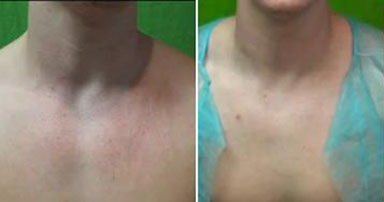Rosacea is an inflammatory skin condition in adults. It is commonly characterized by facial redness, although it can occur elsewhere on the body such as the chest. And often there are small blood vessels that are visible on the skin’s surface. However, other symptoms include:
- Bumps
- Pustules
Los Angeles Rosacea Info- Causes
Rosacea flare ups are triggered by environmental factors which enhance blood flow to the skin. Here are some examples:
1) Hot food and drinks
2) Extreme weather temperatures
3) Sun
4) Alcohol
5) Corticosteroids
6) Exercise
7) Strong emotions (e.g. embarrassment, stress)
The ultimate reason why these reactions occur is likely to be genetic. Certain people have a family history of Rosacea. They carry a genetic predisposition that causes their skin to react to environmental triggers. Usually these individuals have light colored hair, skin and eyes.
Information on Rosacea Phases
Individuals in Los Angeles who have Rosacea may find that their flare up episodes are triggered by sun exposure. Besides understanding what environmental factors activate the condition, patients should also be familiar with information on the different Rosacea phases.
- The pre-Rosacea phase is characterized by a general redness
- In the Vascular Rosacea phase, the skin will show large blood vessels
- The Inflammatory Rosacea phase is characterized by small red bumps and pustules
- The Sebaceous hyperplasia phases involves tissue growth. Usually this occurs in the nose. Not every Rosacea patient reaches this point.
Los Angeles Rosacea Info- Laser Treatment
Los Angeles Rosacea patients may want to know about laser treatment for their condition. Laser procedures will usually treat two types of symptoms:
1. Flushing and redness
2. Sebaceous hyperplasia (tissue growth)
Rosacea Information on The V-beam Laser – Getting Rid of Skin Redness
The pulsed dye Vbeam laser is a promising treatment for Rosacea. It can clear the flushing, redness and dilated blood vessels using wavelengths between 585-595nm.
The laser energy enters the unwanted blood vessels when it is absorbed by oxygenated hemoglobin. The heat from this process will destroy the endothelium lining. The blood vessels close off. And eventually this useless tissue will be carried away by the body’s lymphatic system.
Rosacea Information The CO2 Laser-Treating Tissue Growth
Ablative procedures can be performed with the CO2 laser. This means that unwanted cells can be removed through a vaporization process.
The bulbous tissue growth sebaceous hyperplasia can be minimized with the help of this laser. Prior to this technology, this Rosacea phase was treated with dermabrasion and surgical tools.
Los Angeles Rosacea Info – Patient Experience With the Vbeam Laser
Some people are predisposed to experiencing Rosacea symptoms on their chest. This Los Angeles patient is an example. The redness was getting worse. He underwent three Vbeam laser sessions to get rid of the blood vessels causing this problem. Here are before and after pictures.
- Los Angeles patient before and after treatment of Rosacea with the Vbeam laser
The Vbeam laser effectively cleared the manifestation of red plaque on his chest. And the patient was very pleased with the outcome of his procedure.
Los Angeles Rosacea Treatment Info-Medications
Rosacea bumps can be treated with medication. These drugs are often used to treat common acne. Examples include:
1) Oral antibiotics
2) Topical antibiotics
3) Retinoids
Sebaceous hyperplasia can be treated with oral isotretinoin, another medication used for common acne.
Topical Metronidazole has also been effective for addressing Rosacea bumps. However, it is not effective for acne.
If an acne-like condition is present and responds well to the Metronidazole, it is probably Rosacea and not acne vulgaris.
Speaking To a Los Angeles Doctor About Your Rosacea Symptoms
Los Angeles Rosacea Info– If you feel you have Rosacea, it is important to see a board certified dermatologist right away. What may look like Rosacea can actually be conditions that are more serious (e.g. subacute cutaneous lupus erythematosus).
Fine Touch Dermatology offers complimentary consultations for patients who want to inquire about treatment procedures.

